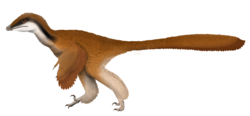Biology:Papiliovenator
| Papiliovenator | |
|---|---|

| |
| Holotype skull diagram | |
| Scientific classification | |
| Domain: | Eukaryota |
| Kingdom: | Animalia |
| Phylum: | Chordata |
| Clade: | Dinosauria |
| Clade: | Saurischia |
| Clade: | Theropoda |
| Family: | †Troodontidae |
| Genus: | †Papiliovenator Pei et al., 2021 |
| Species: | †P. neimengguensis
|
| Binomial name | |
| †Papiliovenator neimengguensis Pei et al., 2021
| |
Papiliovenator (meaning "butterfly hunter", after a butterfly-shaped feature on its first two dorsal vertebrae) is a genus of troodontid theropod dinosaur from the Bayan Mandahu Formation of Inner Mongolia, China . The type and only species is Papiliovenator neimengguensis.[1]
Description
The holotype, BNMNH-PV030, is a partial, semi-articulated subadult skeleton consisting of a nearly complete cranium and other postcranial bones. Uniquely, its snout was short and subtriangular, more similar to that of Early Cretaceous troodontids such as Mei long than the long, low snouts of Late Cretaceous troodontids. This and other unique traits of its skeleton suggest a high diversity of troodontid morphotypes in the Late Cretaceous Gobi Desert.[1]
Classification
Pei et al. recover Papiliovenator as the earliest-diverging member of a clade consisting of all Late Cretaceous troodontids except for Almas ukhaa.[1]
| ||||||||||||||||||||||||||||||||||||||||||||||||||||||||||||||||||||||||||||||||||
References
- ↑ 1.0 1.1 1.2 Pei, R.; Qin, Yuying; Wen, Aishu; Zhao, Q.; Wang, Z.; Liu, Z.; Guo, W.; Liu, P. et al. (2022). "A New Troodontid from the Upper Cretaceous Gobi Basin of Inner Mongolia, China". Cretaceous Research 130: Article 105052. doi:10.1016/j.cretres.2021.105052.
Wikidata ☰ Q108760827 entry
 |


